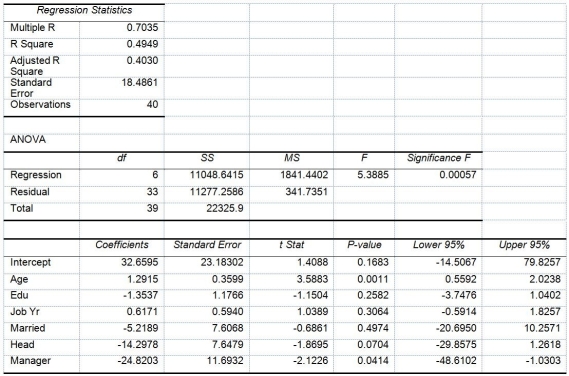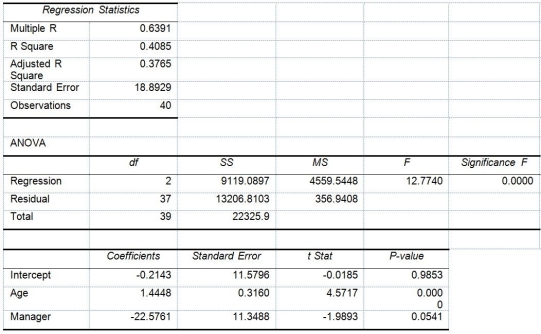TABLE 17-10
Given below are results from the regression analysis where the dependent variable is the number of weeks a worker is unemployed due to a layoff (Unemploy) and the independent variables are the age of the worker (Age) ,the number of years of education received (Edu) ,the number of years at the previous job (Job Yr) ,a dummy variable for marital status (Married: 1 = married,0 = otherwise) ,a dummy variable for head of household (Head: 1 = yes,0 = no) and a dummy variable for management position (Manager: 1 = yes,0 = no) .We shall call this Model 1.The coefficient of partial determination (  ) of each of the 6 predictors are,respectively,0.2807,0.0386,0.0317,0.0141,0.0958,and 0.1201.
) of each of the 6 predictors are,respectively,0.2807,0.0386,0.0317,0.0141,0.0958,and 0.1201.  Model 2 is the regression analysis where the dependent variable is Unemploy and the independent variables are Age and Manager.The results of the regression analysis are given below:
Model 2 is the regression analysis where the dependent variable is Unemploy and the independent variables are Age and Manager.The results of the regression analysis are given below: 
-Referring to Table 17-10,Model 1,which of the following is the correct alternative hypothesis to test whether being married or not makes a difference in the mean number of weeks a worker is unemployed due to a layoff while holding constant the effect of all the other independent variables?
Definitions:
Descriptive Evaluations
Assessments that provide detailed descriptions of performance, typically focusing on strengths, weaknesses, and areas for improvement.
Sophisticated Training Evaluations
Advanced methods of assessing the effectiveness and impact of training programs, often involving qualitative and quantitative analysis.
Declarative Learning
The process of acquiring information that one can speak about, involving the memorization and recall of facts and figures.
Learning Measure
A method or tool used to assess the effectiveness of educational programs, training, or learning processes.
Q6: Referring to Table 18-8,an <img src="https://d2lvgg3v3hfg70.cloudfront.net/TB2970/.jpg" alt="Referring
Q18: True or False: The Paasche price index
Q29: Referring to Table 16-9,if one decides to
Q30: Referring to Table 14-5,what are the predicted
Q97: Referring to Table 19-1,if the probability of
Q126: Referring to Table 18-5,a p control chart
Q132: Referring to Table 17-1,which of the independent
Q135: Referring to Table 17-1,what is the predicted
Q166: Referring to Table 14-4,suppose the builder wants
Q204: True or False: Referring to Table 17-8,you